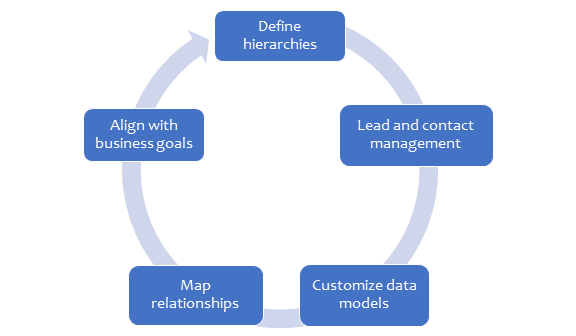
Managing customer relationships becomes increasingly difficult when critical data is scattered across systems. Due to siloed customer information, sales teams often encounter delays, missed opportunities, and inconsistent messaging. How can a team deliver meaningful customer engagement when half the story is missing? This lack of visibility impacts efficiency and limits the ability to respond strategically.
To overcome these challenges, businesses are turning to a 360-degree account view. This approach consolidates scattered customer data into a single, unified source of truth. It offers complete visibility across the customer lifecycle and enables teams to act with greater coordination and precision.
As a trusted Salesforce Summit partner, zeb guides organizations through this transformation with strategic implementation and hands-on expertise.
What is a 360-degree account view?
A 360-degree account view offers a unified, detailed picture of every customer interaction across departments and touchpoints. This comprehensive view allows businesses to deliver personalized, data-driven experiences that resonate with buyers and strengthen long-term relationships.
In a B2B sales environment, this approach supports account-based selling by consolidating information on stakeholders, communication history, and business needs. With tools like Salesforce Einstein Analytics (CRM Analytics), organizations can access predictive insights such as churn risk, upsell potential, or the likelihood of conversion, enabling sales teams to take timely, informed actions. They drive workflow automation that reduces manual effort and facilitates consistent engagement.
Setting up Salesforce Sales Cloud for comprehensive account management
Here’s how businesses can structure their Salesforce Sales Cloud setup for maximum visibility and productivity:
- Define Hierarchies: Establish a clear account and contact structure to reflect organizational relationships.
- Lead and Contact Management: Track and nurture prospects efficiently to streamline the sales pipeline.
- Customize Data Models: Adapt Salesforce data structures to fit your unique business requirements.
- Map Relationships: Connect related accounts, contacts, and opportunities for contextual insights.
- Align with Business Goals: Ensure your CRM setup supports strategic objectives and measurable outcomes.

Integrating customer data across multiple channels
To achieve a complete account view, businesses must gather data from the client’s interaction point, email, web activity, social media, customer service, and marketing platforms. The following table outlines how Salesforce tools and integrations help unify these data sources effectively:
| Channel | Data Collected | Integration Tools | Purpose |
|---|---|---|---|
| Open rates, responses, and campaign activity | Salesforce Data Cloud, Marketing Cloud | Understand engagement and interest levels | |
| Web activity | Page visits, form fills, and browsing behavior | Salesforce Data Cloud, MuleSoft | Track digital behavior to personalize follow-up |
| Social Media | Mentions, interactions, campaign metrics | Social Studio, MuleSoft | Monitor brand engagement and sentiment |
| Customer Service | Support tickets, resolution history | Service Cloud, MuleSoft | Inform sales of the recent service context |
| Marketing Platforms | Lead source, nurture activity | Marketing Data Cloud, third-party connectors Data Cloud | Align sales and marketing outreach |
These integrations enable real-time synchronization of customer data while supporting data consistency, quality, and privacy compliance. Whether leveraging native Salesforce tools or third-party connectors, the goal remains the same: ensure a reliable, complete view of every end user.
Customizing dashboards for a holistic account view
Dashboards transform data into actionable insights. In Salesforce, teams can design interactive, role-based dashboards tailored to the needs of different users.
For sales representatives, key metrics might include deal stages, meeting notes, or recent communications, while managers may focus on pipeline performance, account health scores, or team productivity. Executives typically require a higher-level view of revenue forecasts, market trends, and strategic accounts, and that’s where customization plays a key role. By tailoring dashboards to each role, teams gain access to the specific insights they need to support responsibilities and drive informed decision-making.
Real-world use case
A mid-sized enterprise with multiple functional teams faced challenges due to fragmented customer data spread across sales, support, and marketing systems. Without a centralized view, teams lacked the transparency needed to deliver consistent and timely interactions.
To resolve this, the company adopted Salesforce Sales Cloud and used MuleSoft to integrate data from multiple critical systems, including Azure Data Factory, Salesforce Data Cloud, legacy CRMs, and marketing platforms. By bringing together information from these diverse customer touchpoints, they created a centralized, 360-degree account view accessible to all customer-facing teams. This unified approach led to stronger customer retention, faster onboarding cycles, and empowered teams with real-time insights that elevated engagement and improved operational responsiveness.
Best practices for engagement and retention using the 360-degree view
To maximize the impact of a 360-degree account view:
- Align sales and customer success teams around shared insights and coordinated workflows.
- Engage proactively using behavioral data, such as product usage patterns or support history, to anticipate needs and deliver timely follow-ups.
- Maintain data hygiene by regularly reviewing and updating records to ensure accuracy.
- Continuously refine dashboards and reports to reflect evolving business priorities.
Refining marketing with Salesforce Customer 360
With a 360-degree customer view, companies can significantly refine their marketing strategies by leveraging unified insights from sales, support, and engagement data. This comprehensive perspective allows marketing teams to personalize campaign messaging based on individual preferences and past behaviors, ensuring higher relevance and response rates. By analyzing interaction patterns, teams can time their campaigns for maximum impact, targeting customers when they’re most likely to engage.
Audience segmentation also becomes more precise, allowing for dynamic groupings based on lifecycle stage, product interest, or geographic location. Additionally, marketing efforts can be closely aligned with sales and service activities to maintain consistency across touchpoints. Real-time insights enable automated triggers for follow-up campaigns such as reminders for abandoned carts or recommendations based on recent activity. Overall, Customer 360 empowers marketers to deliver more targeted, timely, and context-aware campaigns that reflect each customer’s full journey.
Conclusion
A 360-degree account view is more than a technology initiative; it’s a strategic shift in how organizations understand and serve their customers. With the right tools and a structured approach, sales teams can access the full context they need to strengthen relationships and improve outcomes.
Collaborating with experienced partners like zeb ensures not just a smooth Salesforce implementation but a scalable foundation for smarter selling and sustainable growth. We specialize in delivering Salesforce solutions that drive visibility and efficiency.
Contact us to explore how we can support your field service transformation.